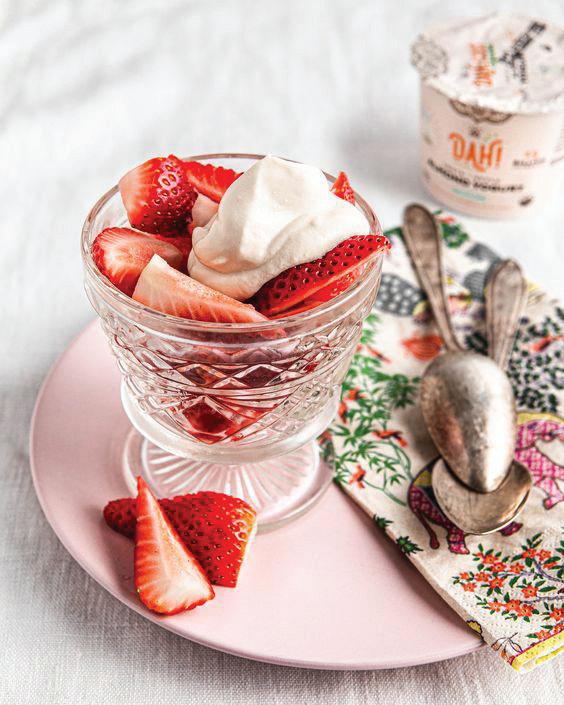
4 minute read
DAIRY
The Cultured Yogurt
Yogurt is a semi-solid, processed and fermented milk product, mostly prepared from cow’s milk. Yogurt is produced by the act of bacterial fermentation of milk. The bacteria used to make this dairy product are known as ‘yogurt cultures.’ Although milk from various domestic animals are used for yogurt production, but most commercial yogurt production units across the globe now use cow’s milk to maintain a consistent taste. However, yogurt can be prepared with any type of milk; be it from cow, buffalo, goat, and sheep. But nowadays, soymilk is also seen as a new-age component for commercial yogurt preparation.
Advertisement
Since time immemorial, this form of curd is being consumed in almost every part of the world with variations in forms and taste. Generally taste and texture of yogurt differs according to the quality of the milk used, which varies from one region to another. It is still among the most popular dairy items of our day-to-day menus, whether we live in cosmopolitan or rural India.
Curdling Up
Yogurt is a semi-solid, processed and fermented milk product, mostly available with a consistency similar to that of thick, creamy and whisked curd. To relish yogurt, one has to use good quality milk that contains a higher concentration of solids than normal milk. The milk that possesses more solid content bestows a thicker and firmer texture to the yogurt. In its preparation route, milk is processed and pasteurised for attaining a good output. Often, most producers add non-fat dry milk (NFDM) or milk powder to thicken the milk.
Inoculating certain bacteria into milk, which work as starter culture, makes yogurt. They are commonly known as streptococcus thermophilus and lactobacillus bulgaricus. Yogurt is processed and packaged in such a way that it has longer shelf life than the natural curd. Curd is prepared by seeding natural bacteria called lactobacillus, thus the milk does not need to be processed before making curd. However, before preparing yogurt, milk has to be processed and then it is inoculated with starter culture and other additives that infuse flavour and aroma. The sweetened form of yogurt is available in various mouth-watering flavours and attractive packaging.
Various types of milk can be used for producing yogurt, such as whole milk, partially skimmed milk, skimmed milk or full cream. Despite this, for yogurt production, one needs to confirm certain criteria in regard to quality of raw milk for yogurt production. It helps to ensure good development of yogurt culture.
The milk with low bacteria count is preferred for making yogurt, as it helps to keep the product for longer duration. The milk should be free from antibiotics, sanitising chemicals, mastitis milk, colostrums, and rancid cream. Also, it is ensured that there is no contamination by bacteriophages.
Thickening and Stabilising
In Europe, yogurt tends to be ‘runny’, but in USA people prefer to eat a little thicker and firm yogurt, hence the concentration of powdered milk depends on the choice of required consistency in yogurt.
In the era of health food, soymilk with its high protein content is replacing the natural one. This is even evident in the yogurt market where it is made with soymilk in many countries. Still this has a major disadvantage. Soymilk does not contain lactose, and absence of lactose and certain type of carbohydrate sugar deters the fermentation, which becomes a major obstacle in the growth of yogurt culture. Besides this, soymilk should be blended with some thickening agents like gelatin, pectin or agar powder. One needs to dissolve the agar powder in cold water and then bring it to a boil before using it.
In the process of preparing yogurt, one needs other dairy products as ingredients such as concentrated skimmed milk, non-fat dry milk, whey and lactose. These are often used to increase the non-fat solid contents in the milk.
A certain amount of sweetener is added for the sweetened form of yogurt. It can be glucose or sucrose, or high intensity sweeteners e.g. aspartame, etc. Besides all these, one needs to add some stabilisers that give yogurt a firm consistency, which could be in the form of gelatin, carboxymethyl cellulose, locust bean Guar, alginates, carrageenans and whey protein concentrates.
Consider the fact that absence of lactose content or some type of carbohydrate sugar will not allow the culture to grow. To eschew this state, it becomes necessary to add some amount of sugar, glucose or sucrose at a rate of about 2 to 3 percent by weight of the whole mixture.
Some of the famous yogurt recipes are the Continental, French, and Swiss. Two popular traditionally Indian forms of yogurt are delightfully consumed as desserts in India. One is mishti doi, which is flavoured with caramel sugar and served in earthen pots and other is shreekhand, which is sweetened after draining the whey from the set curd.
Yogurt Beverage
In the field of cold beverages, many varieties of yogurt drinks are gaining popularity. These products are essentially prepared in stirred style in which total solids content do not exceed more than 11 percent. Manufacturing procedure of yogurt beverage differs from normal yogurt process where the mixture is homogenised further to reduce viscosity. The required flavours and colours are added invariably in the mixture while processing.
Heat treatment is applied at the end of the process to extend the storage life of the product. HTST pasteurisation with aseptic processing at 2-4°C give a shelf life of several weeks, whereas UHT processes with aseptic packaging give a shelf life of several weeks at ambient temperature. ■










